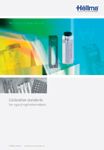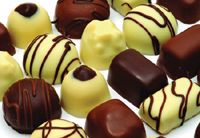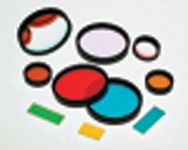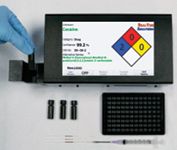Products
Product Resources
UV–vis spectrophotometer
Thermo Fisher Scientific's Evolution Array UV–vis spectrophotometer includes a photodiode-array design intended to improve laboratory throughput with fast acquisition of full-spectrum UV–vis data. The instrument is designed for method development and sample analysis in QA/QC, pharmaceutical, life science, materials science, and educational laboratories. Full-spectrum data (190–1100 nm) reportedly are acquired in less than 1 s for routine data applications and at nearly 50 points/s for advanced kinetics applications. The instrument operates using the company's VISIONcollect software. Thermo Fisher Scientific, Madison, WI;

X-ray digital signal processor
The Mercury four-channel digital signal processor from XIA is designed for high-rate, high-resolution energy dispersive X-ray spectroscopy and mapping. The signal processor reportedly provides up to 1 Mcps output per channel. According to the company, the signal processor is compatible with most detector types and preamplifiers. XIA LLC, Hayward, CA;

Confocal Raman microscope
The Voyage confocal Raman microscope from B&W Tek is designed to deliver true confocality and flexibility. The microscope is available as a complete system or as an attachment for Olympus BX41/51/61 and Nikon Eclipse 80i upright microscopes. According to the company, the microscope can be equipped with optional laser shields for CDRH class 1a safety compliance. B&W Tek, Newark, DE;

Low-noise current controller
Wavelength Electronics' low-noise current controller is designed for use with quantum cascade lasers used in sensors for trace atmospheric gas analysis. The controller was developed by the Department of Energy's Pacific Northwest National Laboratory and has been licensed to the company. The controller reportedly reduces the noise on the laser's power source, which enables measurement of lower levels of trace gases. Wavelength Electronics, Inc., Bozeman, MT;

Fiber-optic UV dissolution testing system
The Opt Diss fiber-optic dissolution testing system from Distek is intended for analyzing samples directly in the dissolution vessel. According to the company, the fiber-optic design improves precision and accuracy and eliminates sampling errors. The system reportedly can be used with most standard dissolution systems performing formulations development, quality control, and process monitoring tests. Distek, Inc., North Brunswick, NJ;

Laser-driven light sources
Energetiq's LDLS laser-driven light sources for broadband DUV, visible, and IR light are designed for various spectroscopy applications and any application requiring ultralong lamp life. According to the company, the sources' design enables them to be used as a single UV–vis source alternative to multiple lamps or lasers. Filters can be used to limit the substrate exposure to a defined band. The EQ-1000 is designed for high power applications, the EQ-1500 and 1510 are designed to provide high spectral radiance, and the EQ-99 is designed for high brightness in a compact size. Energetiq Technology, Inc., Woburn, MA;

Calibration standards
Hellma's liquid and glass calibration filters for testing spectrophotometers are produced in a DIN EN ISO 17025-accredited calibration laboratory. The accreditation reportedly ensures traceability of calibrations performed to references of NIST, by which an international correlation of measurement results is obtained. Hellma USA, Inc., Plainview, NY;

UV-vis spectrophotometer
The BioSpec nano UV-vis spectrophotometer is designed to be a dedicated system for the quantitation of nucleic acids or fluorescent-labeled nucleic acids, protein analysis, and photometric analysis. The spectrophotometer's automated drive mechanism reportedly enables life science researchers to conserve samples and obtain reproducible results. According to the company, the system requires 1 or 2 µL of sample for 0.2- and 0.7-mm pathlengths, respectively. The sample is pipetted onto a measurement plate. No standard rectangular cell is required for ultrasmall sample volumes, although an optional rectangular cell adapter is available. Sample measurement time is 3 s. Shimadzu Scientific Instruments Inc., Columbia, MD;

Raman excitation source
The wavelength-stabilized single-frequency A-Type excitation source from Innovative Photonic Systems is designed for use by Raman system developers. According to the company, the source module contains an integral diode laser, TEC, thermistor, laser line filter, and beam-shaping optics and provides a circularized and collimated Gaussian output beam. It also features a linear tracking photodiode for linear output power measurements. Output power reportedly is greater than 100 mW, the spectral linewidth is less than 0.001 nm, and the power stability is less than 0.5%. The module is available at 785-, 808-, 830-, 976-, 1064-, and 1546-nm wavelengths. Innovative Photonic Systems, Monmouth Junction, NJ;

FT-IR spectrophotometer
The CryoSAS FT-IR spectrophotometer from Bruker is designed as a dedicated system for impurity analysis and quality control of silicon crystals according to SEMI and ASTM standards. The system reportedly is optimized for at-line operation in industrial environments. According to the company, the system combines low-temperature closed-cycle refrigerating devices that require no cryogenic liquids. Bruker Optics, Inc., Billerica, MA;

High-speed spectrometers
The AvaSpec FAST spectrometers from Avantes are designed for high-speed uses such as pulsed-laser applications in the UV–vis and NIR wavelength ranges (200–1100 nm). The F-Series is available in four standard configurations, ranging from 0.2-ms to 0.85-ms minimal integration time. The spectrometers are configured in continuous run mode in which a single external trigger results in a continuous scan of spectra up to a user-defined number of scans; they can also be configured in single-scan mode. Avantes, Inc., Broomfield, CO;

Linear image sensors
Hamamatsu's back-thinned CCD linear image sensors are intended for use with spectrometers. According to the company, the sensors' back-thinned structure provides high sensitivity to UV and NIR wavelengths. The sensors feature a built-in electronic shutter function and a resistive gate structure that reportedly allows readout at up to 10 MHz. The S11155-2048's pixels are 14 µm wide and 500 µm high, and the S11156-2048's pixels are 14 µm wide and 1000 µm high. The devices are available in a 24-pin ceramic DIP package with a quartz glass window. Hamamatsu Corporation, Bridgewater, NJ;

EDXRF spectrometer
The NEX CG energy dispersive X-ray fluorescence (EDXRF) spectrometer from Rigaku is designed for rapid qualitative and quantitative determination of major and minor atomic elements in various sample types with minimal standards. The benchtop system reportedly can nondestructively analyze elements ranging from 11Na to 92U in solids, liquids, powders, and thin films. According to the company, the system features a close-coupled Cartesian geometry optical kernel that increases signal-to-noise, and sensitivity is improved by the instrument's use of secondary target excitation. Applied Rigaku Technologies, Inc., Auburn Hills, MI;

Atomic absorption application note
An application note from Thermo Fisher Scientific discusses the analysis of cadmium in chocolate using atomic absorption (AA) spectrophotometry. The note describes the use of the company's iCE 3500 AA spectrophotometer and SOLAAR software for analyzing the heavy metal. "The Analysis of Cadmium in Chocolate by Graphite Furnace Atomic Absorption Spectrophotometry" is available for downloading via the literature library on the company's website. Thermo Fisher Scientific, Madison, WI;

UV–vis spectrophotometer
Agilent's 8453 UV–vis spectrophotometer is designed with a photodiode-array detector for measurements across the entire UV–vis spectrum (190–1100 nm) in less than 1 s. According to the company, the design ensures reliability and repeatable readings. Coupled with the company's UV-Visible ChemStation software, the system reportedly provides data analysis, data archival, and compliance with pharmacopoeia requirements and good laboratory practices. Agilent Technologies, Inc., Santa Clara, CA;

Cameras
The Synapse-I cameras from HORIBA Scientific are designed for low light level sensitivity and quantitative measurements in a single measurement. The cameras reportedly combine low noise electronics, large pixels, high QE, and deep cooling to –70 °C. Applications include chemiluminescence, in-vivo imaging, and semiconductor failure analysis. The cameras are available with both front- and back-illuminated CCDs in 512 × 512 and 1024 × 1024 formats and come with either V++ imaging software or VspecPro software for dual imaging and spectroscopy use. Interchangeable mounts allow coupling to either a lens or a range of the company's spectrometers. HORIBA Scientific, Inc., Edison, NJ;

Bandpass filters
TECHSPEC high-transmission OD6 bandpass filters from Edmund Optics are matched to common fluorophores used in fluorescence imaging applications. The filters reportedly feature greater than 93% transmission and greater than OD6 blocking outside of the passband. According to the company, the filters can be used in spectroscopy and clinical chemistry applications and biotech instrumentation. Each filter is hard sputtered coated on a single fused-silica substrated and is mounted in a black anodized ring. Edmund Optics, Barrington, NJ;

XRF inorganic elemental analyzer
EDAX's Orbis micro-XRF inorganic elemental analyzer is designed to perform nondestructive measurements that require minimal sample preparation and provide improved sensitivity over SEM and EDS methods. The analyzer includes a motorized turret for coaxial sample view and X-ray analysis. Primary beam filters can be used with X-ray optics for micrometer to millimeter spot elemental analyses. Applications include forensics, materials analysis, failure analysis, and elemental imaging. EDAX, Inc., Mahwah, NJ;

Optical filters
Optical filters designed with sputtered coatings are available from CVI Melles Griot. The narrowband, broadband, and edge filters for fluorescence, microscopy, flow cytometry, and image processing reportedly provide 5–6 OD blocking and maintain a transmission of greater than 98%. According to the company, standard and custom designs are available. CVI Melles Griot, Carlsbad, CA;

Silicon drift detector
The Super SDD silicon drift detector from Amptek is designed for high count rate applications in handheld systems and bench-top analyzers. The X-ray detector, preamplifier, and cooler system reportedly are thermoelectrically cooled. The input FET and a feedback circuit are mounted on the detector's two-stage cooler and are kept at approximately -55 °C. According to the company, the 25 mm2 × 500 µm detector provides an FWHM resolution of 127 eV, a peaking time of 11.2 µs, and a peak-to-background ratio of 8000. Amptek Inc., Bedford, MA;

Ratio beam spectrophotometer
The U-5100 ratio beam spectrophotometer from Hitachi is designed for applications ranging from teaching to routine QC, biotech, and environmental testing. The system has a wavelength range of 190–1100 nm, a spectral bandwidth of 5 nm, and LCD screen dimensions of 120 mm × 90 mm. According to the company, it can perform photometry, wavelength scan, time scan, and absorbance ratio measurements. The spectrophotometer includes a six-position automatic cell changer. Hitachi High Technologies America, Inc., Pleasanton, CA;
www.hitachi-hta.com/spectroscopy

Surface-enhanced Raman products
The Chemical Residue Detector is a handheld SERS analyzer. According to the company, it is capable of detecting trace chemicals in the lab or the field. Samples are reportedly collected in SERS-active capillaries or vials, and chemicals in liquids or residues on surfaces such as drugs, explosives, pesticides, and food or water contaminants are then identified. The SERS capillaries are used to collect liquid samples using a syringe. The 96-well SERS-active plates are designed to enable screening of samples. Real-Time Analyzers, Inc., Middletown, CT;

Mid-IR hollow waveguide accessory
The FlexIR mid-IR hollow waveguide accessory from PIKE Technologies is designed for remote FT-IR sampling. According to the company, the benefits of the hollow waveguides include flexibility, durability, and the capability to cover the mid-IR spectral range with a single probe. ATR, specular, and diffuse reflectance probes are available. Applications include the FT-IR measurement of samples that are not conducive to in-compartment sampling due to physical size or chemical properties and for in-situ IR testing. According to the company, the accessory is compatible with most FT-IR spectrometers. PIKE Technologies, Madison, WI;

Photovoltaic measurement system
Newport Corporation's Oriel IQE-200 photovoltaic cell measurement system is designed for simultaneous measurement of the external and internal quantum efficiency of solar cells, detectors, and other photon-to-charge converting devices. The system reportedly splits the beam to allow for concurrent measurements. The system includes a light source, a monochromator, and related electronics and software. According to the company, the system can be used for the measurement of silicon-based cells, amorphous and mono/poly crystalline, thin-film cells, copper indium gallium diselenide, and cadmium telluride. Newport Corporation, Irvine, CA;


LIBS Illuminates the Hidden Health Risks of Indoor Welding and Soldering
April 23rd 2025A new dual-spectroscopy approach reveals real-time pollution threats in indoor workspaces. Chinese researchers have pioneered the use of laser-induced breakdown spectroscopy (LIBS) and aerosol mass spectrometry to uncover and monitor harmful heavy metal and dust emissions from soldering and welding in real-time. These complementary tools offer a fast, accurate means to evaluate air quality threats in industrial and indoor environments—where people spend most of their time.
NIR Spectroscopy Explored as Sustainable Approach to Detecting Bovine Mastitis
April 23rd 2025A new study published in Applied Food Research demonstrates that near-infrared spectroscopy (NIRS) can effectively detect subclinical bovine mastitis in milk, offering a fast, non-invasive method to guide targeted antibiotic treatment and support sustainable dairy practices.